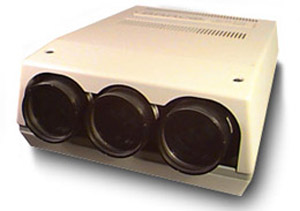 |
||||||||||||
| Home |
|
Products For Sale |
FAQs, Tips, Manuals |
Referral List |
|
Photo Gallery |
|
Links |
|
Contact Us |
|
|
||||||||||||||||||||||||||
Barco made many versions of similar analog convergence sets back before 1990. These included the Barco 1000, 1001, 1500, 400 and 600, the Vision and the Data. There was many small variations between these sets, but there were also basic similarities between them, in fact you can see a lot of similarities between the very early Barco chassis and the later models from 1995-1999. Barco started with video projectors around 1983-1984 with the Barco Vision,
Barco Data and Vstar lines. I understand that the Vstar models were made
specifically for the airline industry and the all of the projectors that I have
seen from this era have weak tubes and usually have numerous circuit problems
due to the age. I do not actively sell projectors that are this old, although I
do have the service manuals and some parts for these sets. Generally speaking, the Vision projectors accepted a video only signal either video a composite video connector, possibly an S-video connector or via an RGB input. Remember that these sets were made pre-1990 generally and back then, video signals could be given via an RGB signal, but the resolution was limited to 320 X 240. (back in the early days of computers, that was high resolution!). Even the sets that are labelled ‘HDTV’ on the case such as the Vision 1500, the resolution maxed out at 640 X 480, and cannot sync to a modern day HDTV signal. Barco then came out with the Barco 400 and Barco 600 video projectors. The 400 and 600 are very similar in design and performance. They use 7” SD-187 Sony tubes with ES focus, have analog convergence, and scan to 64 Khz with 600 lumens light output. Thousands have been sold, and many are on the surplus market. These projectors must be used in conjunction with either a little plug in controller module on the back of the projector, or with a Barco RCVDS 4 switcher unit that acts as a video selector and video to RGB decoder. Note that these two projectors usually only have the RGB inputs working despite the fact that they have video input connectors on the projector. The video card was an option on these sets, and hardly any of the sets I get in have had this video card installed. Also, most of the surplus projectors do not come with the plug in controller or with the RCVDS 4 unit, so you may end up needing more components before you get a watchable picture. Barco 1000, 1001, and 1500: These are a series of 9” analog convergence projectors that Barco came out with from about 1989 to 1993. All very similar to the Barco 600 chassis, but used 9” Sony ES focus tubes, called the SD-146A. A great picture when properly set up, but Barco drove these tubes quite hard, and sudden tube failures were common. These tubes are hard to find on the used market, and are insanely expensive if purchased new. Some of these sets were video and S-video only, specifically the Vision versions of these sets. Others, sometimes labeled ‘HDTV’ would only scan to 32 Khz, and will not support the 1080i HDTV standard of today (remember that these sets came out in 1986 to 1989, long before today’s HDTV hit the market). Some sets scan to 64 Khz and are good to line quadrupling. 1000 to 1500 lumen rating from these 9” ES focusing sets. Data sets prior to 1990 could usually scan to 42 Khz, so they would lock to a
1080i signal, but check the Barco spreadsheets available on the
Downloads page or the
Barco Specifications
page for the max H scan rate just to be sure. Note a couple of things about these older projectors:
Overall however, it’s good to see analog convergence sets still working strong out there that are approaching 20 years old. Let’s see a digital projector do that!
To see how this projector ranks in relation to other projectors for use in a
home theater environment see the Projector Rankings
page. For an overview and history of Barco see the CRT Primer. See the Advanced Procedures page for various DIY instructions on maintaining and improving CRT projectors. Having problems with your Barco projector? Don't forget to check the Troubleshooting Tips section!
|
|
|||||||||||||||||||||||||
© Copyright CurtPalme.com. All Rights Reserved. |


